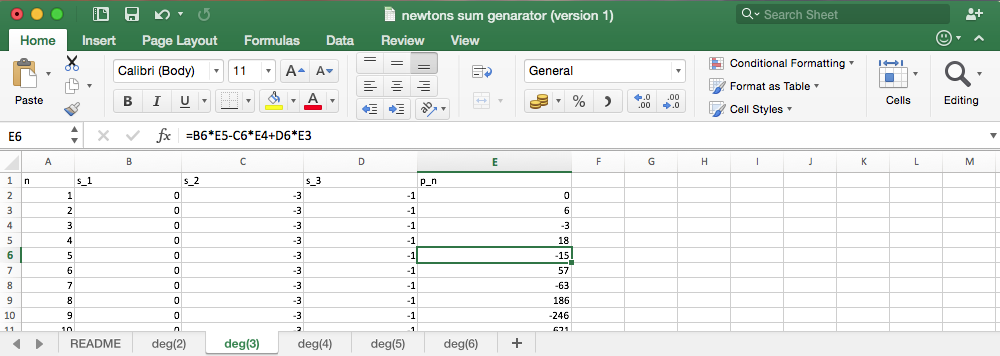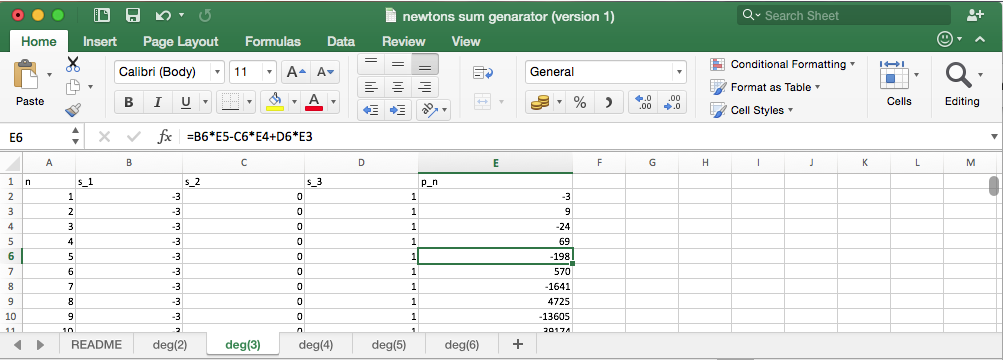Transformation of Roots!
P ( x ) = x 3 − 3 x + 1
Let Q ( x ) = x 3 + A x 2 + B x + C be a polynomial with integer coefficients such that its roots are the fifth powers of the roots of P ( x ) . Evaluate A + B + C .
The answer is -182.
This section requires Javascript.
You are seeing this because something didn't load right. We suggest you, (a) try
refreshing the page, (b) enabling javascript if it is disabled on your browser and,
finally, (c)
loading the
non-javascript version of this page
. We're sorry about the hassle.
4 solutions
Thanks for the solution. I know there must be a systematic way to solve this.
Log in to reply
Well, your solution is also a systematic one. The solution I have posted will be easier only if one uses a Scientific Calculator. Else, solving it manually is equally tedious as compared to yours.
Log in to reply
I use Excel spreadsheet. I was trained as an engineer. Numerical methods are acceptable methods to solve problems.
How exactly are you defining the " companion matrix " for the polynomial P ( x ) ?
According to both Wikipedia and Wolfram MathWorld, what you've written as A is actually the transpose of the companion matrix of P ( x ) .
If you're going to use a non-standard definition, do mention it explicitly in your solution so as to avoid any ambiguity.
Log in to reply
The original companion matrix or it's transpose, both doesn't matter in this problem, as the determinant of a matrix and it's transpose are equal. Still, to avoid ambiguity, I've edited the solution. Thanks :)
Let the roots of P ( x ) be a , b and c , therefore, the roots of Q ( x ) are a 5 , b 5 and c 5 . By Vieta's formulas:
⎩ ⎪ ⎨ ⎪ ⎧ a + b + c a b + b c + c a a b c = 0 = − 3 = − 1 and ⎩ ⎪ ⎨ ⎪ ⎧ A = a 5 + b 5 + c 5 B = a 5 b 5 + b 5 c 5 + c 5 a 5 C = a 5 b 5 c 5
\(\begin{array} {} a+b+c = 0 & = 0 \\ a^2+b^2+c^2 = (a+b+c)(a+b+c) - 2(ab+bc+ca) = 0-2(-3) & = 6 \\ a^3+b^3+c^3 = (0) (a^2+b^2+c^2) +3(a+b+c) + 3abc = 0+3(0) +3(-1) & = -3 \\ a^4+b^4+c^4 = 3(a^2+b^2+c^2) -(a+b+c) = 3(6) -(0) & = 18 \\ a^5+b^5+c^5 = 3(a^3+b^3+c^3) -(a^2+b^2+c^2) = 0+3(-3) -(6) & = -15 \end{array} \)
⇒ A = 1 5
Let α = a b , β = b c and γ = c a , therefore, B = a 5 b 5 + b 5 c 5 + c 5 a 5 = α 5 + β 5 + γ 5 and, we have:
⎩ ⎪ ⎨ ⎪ ⎧ α + β + γ = a b + b c + c a α β + β γ + γ α = a b 2 c + a b c 2 + a 2 b c = a b c ( a + b + c ) α β γ = ( a b c ) 2 = − 3 = 0 = 1
\(\begin{array} {} \alpha+\beta+\gamma = -3 & = -3 \\ \alpha^2+\beta^2+\gamma^2 = (-3)^2 -2(0) & = 9 \\ \alpha^3 + \beta^3 + \gamma^3 = -3(9) -0+3(1) & = -24 \\ \alpha^4 + \beta^4 + \gamma^4 = -3(-24) + (-3) & = 68 \\ \alpha^5 + \beta^5 + \gamma^5 = -3(69) + 9 & = -198 \end{array} \)
⇒ B = − 1 9 8
C = − ( a b c ) 5 = − ( − 1 ) 5 = 1
⇒ A + B + C = 1 5 − 1 9 8 + 1 = − 1 8 2
Sir, There are a certain number of technical issues in your solution
1) You have written α 3 + β 3 + γ 3 twice.
2) in the part where you calculate C, you have written C = − ( a b c ) 5 " = = ( − 1 ) 5 " = 1 It should have been C = − ( a b c ) 5 = − ( − 1 ) 5 = 1
Log in to reply
Thanks. I have done the changes.
@Chew-Seong Cheong Can you observe that:
T 5 = 2 1 ( S 5 2 − S 1 0 )
where
T n = c y c ∑ a n b n and S n = c y c ∑ a n
Log in to reply
Let me check. Is it for all cases in general?
Log in to reply
Can't say, but for three variables a , b , c in cyclic mode, yes!
i used an excel program to solve, i will explain: by vieta's:
P
⎩
⎪
⎨
⎪
⎧
α
+
β
+
γ
=
0
α
β
+
β
γ
+
γ
α
=
−
3
α
β
γ
=
−
1
Q
⎩
⎪
⎨
⎪
⎧
A
=
−
(
α
5
+
β
5
+
γ
5
)
B
=
(
α
β
)
5
+
(
β
γ
)
5
+
(
γ
α
)
5
C
=
−
(
α
β
γ
)
5
i hope you all know newtons sum, it pretty basic to find A using newtons sum:
 A
=
−
(
α
5
+
β
5
+
γ
5
)
=
−
(
−
1
5
)
=
1
5
and
C
=
−
(
−
α
β
γ
)
5
=
−
(
−
1
)
5
=
1
B is the rather fun part. if we consider roots to be,
α
β
,
β
γ
,
γ
α
then
⎩
⎪
⎨
⎪
⎧
s
1
=
α
β
+
β
γ
+
γ
α
=
−
3
s
2
=
α
β
(
β
γ
)
+
β
γ
(
γ
α
)
+
γ
α
(
α
β
)
=
α
β
γ
(
α
+
β
+
γ
)
=
−
1
(
0
)
=
0
s
3
=
α
β
(
β
γ
)
(
γ
α
)
=
(
α
β
γ
)
2
=
(
−
1
)
2
=
1
putting these values:
A
=
−
(
α
5
+
β
5
+
γ
5
)
=
−
(
−
1
5
)
=
1
5
and
C
=
−
(
−
α
β
γ
)
5
=
−
(
−
1
)
5
=
1
B is the rather fun part. if we consider roots to be,
α
β
,
β
γ
,
γ
α
then
⎩
⎪
⎨
⎪
⎧
s
1
=
α
β
+
β
γ
+
γ
α
=
−
3
s
2
=
α
β
(
β
γ
)
+
β
γ
(
γ
α
)
+
γ
α
(
α
β
)
=
α
β
γ
(
α
+
β
+
γ
)
=
−
1
(
0
)
=
0
s
3
=
α
β
(
β
γ
)
(
γ
α
)
=
(
α
β
γ
)
2
=
(
−
1
)
2
=
1
putting these values:
 hence
B
=
(
α
β
)
5
+
(
β
γ
)
5
+
(
γ
α
)
5
=
−
1
9
2
and
A
+
B
+
C
=
1
5
−
1
9
2
+
1
=
−
1
8
2
hence
B
=
(
α
β
)
5
+
(
β
γ
)
5
+
(
γ
α
)
5
=
−
1
9
2
and
A
+
B
+
C
=
1
5
−
1
9
2
+
1
=
−
1
8
2
I don't think I am adding anything new, but here is my proof as I obtained it before reading all your interesting solutions. Let x 1 , x 2 , x 3 be the roots of P ( x ) . Then we define S k = x 1 k + x 2 k + x 3 k where k is any non-negative integer number. Using the Newton's sums we obtain the following
\(\begin{array} {} S_{0}=3\\S_{1}=0\\S_{2}=0. S_{1}+3*2=6\\S_{3}=0*S_{2}+3*S_{1}-S_{0}=-3\\S_{4}=0*S_{3}+3*S_{2}-S_{1}=18\\S_{5}=0*S_{4}+3*S_{3}-S_{2}=-15\\S_{6}=0*S_{5}+3*S_{4}-S_{3}=57\\S_{7}=0*S_{6}+3*S_{5}-S_{4}=-63\\S_{8}=0*S_{7}+3*S_{6}-S_{5}=186\\S_{9}=0*S_{8}+3*S_{7}-S_{6}=-246\\S_{10}=0*S_{9}+3*S_{8}-S_{7}=621\end{array}\)
Obviously A = − S 5 = 1 5 and C = − ( x 1 5 ∗ x 2 5 ∗ x 3 5 ) = − ( x 1 ∗ x 2 ∗ x 3 ) 5 = − ( − 1 ) 5 = 1 . Now let us find B
B = x 1 5 x 2 5 + x 1 5 x 3 5 + x 2 5 x 3 5 = 2 1 ( S 5 2 − S 1 0 ) = 2 1 ( ( − 1 5 ) 2 − 6 2 1 ) = − 1 9 8 So A + B + C = 1 5 + ( − 1 9 8 ) + 1 = − 1 8 2 .
Sir will u write newton sum rule in general form and explain it actually I don't know the rule.
Log in to reply
I think you might want to read about Newton's Identities here in Brilliant.
We'll use the companion matrix (actually we've used the transpose of the companion matrix below, as the determinant of a matrix is equal to the determinant of it's transpose) of the polynomial P ( x ) namely:
A = ⎝ ⎛ 0 0 − 1 1 0 3 0 1 0 ⎠ ⎞ ,
for which the characteristic polynomial is det ( x I − A ) = x 3 − 3 x + 1 . For each integer k ≥ 1 , the zeroes of the characteristic polynomial of A k are the k t h powers of the zeroes of P ( x ) . Taking this into account, we find that Q ( x ) = det ( x I − A 5 ) . It is an easy exercise to see that:
A 5 = ⎝ ⎛ − 3 1 − 9 9 − 6 2 8 − 1 9 − 6 ⎠ ⎞ .
Thus we have Q ( x ) as:
Q ( x ) = det ( x I − A 5 ) = ∣ ∣ ∣ ∣ ∣ ∣ x + 3 − 1 9 − 9 x + 6 − 2 8 1 − 9 x + 6 ∣ ∣ ∣ ∣ ∣ ∣ = x 3 + 1 5 x 2 − 1 9 8 x + 1
Thus A = 1 5 , B = − 1 9 8 , C = 1 , A + B + C = − 1 8 2 .